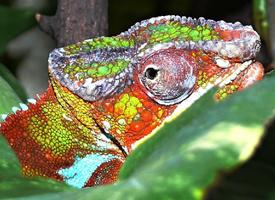
Váhy a míry
| Délka | od 30 do 40 cm |
|---|
Popis zvířete
The Common Chameleon (Chamaeleo chamaeleon), a species of chameleon found primarily in the Mediterranean region, is a remarkable and fascinating creature. This species stands out due to its unique ability to change color, an adaptation that serves various purposes such as communication and temperature regulation, in addition to its primary use for camouflage. The Common Chameleon occupies a range of habitats, from coastal areas to mountains, showing a preference for warmer and sunnier climates. It thrives in environments that offer a mix of trees and shrubs, which are crucial for its arboreal lifestyle.An adult Common Chameleon can reach a length of up to 35 centimeters, although sizes vary significantly among individuals. Its body is distinctively adorned with granular scales that contribute to its ability to blend into its surroundings. The coloration of these reptiles is not fixed; it can vary from green to brown, with patterns that can include stripes and spots, depending on their mood, health, and the environmental conditions. The chameleon's skin changes color through the expansion and contraction of cells containing different pigments, a process that is both fascinating and complex.
One of the most striking features of the Common Chameleon is its eyes. Each eye can move independently, allowing it to have a 360-degree view of its surroundings—a critical adaptation for spotting predators and prey. This, combined with its slow and deliberate movements, makes the Common Chameleon an effective predator. Its diet mainly consists of insects and other small invertebrates. The chameleon's method of catching prey is equally remarkable; it has a long, sticky tongue that can extend at incredible speed and accuracy to snatch up insects.
The Common Chameleon also exhibits interesting reproductive behavior. It is oviparous, meaning the females lay eggs after fertilization. The mating season triggers dramatic changes in color and behavior as males become more vibrant to attract females and display aggression towards rivals. After mating, the female lays a clutch of eggs, which she buries in a shallow hole. The eggs undergo a lengthy incubation period, which can last several months, depending on the temperature of the environment.
Despite its adaptability, the Common Chameleon faces threats from habitat destruction, pollution, and the illegal pet trade. These pressures have led to a decline in some populations, highlighting the need for conservation efforts to ensure the survival of this remarkable species. The Common Chameleon is not just an example of the incredible diversity of life on Earth, but also a reminder of the intricate connections within ecosystems and the importance of preserving natural habitats.
Podobná zvířata
Nové fotografie zvířat
Top 10 zvířat
- Dolphin gull (Leucophaeus scoresbii)
- Japanese macaque (Macaca fuscata)
- Stone loach (Barbatula barbatula)
- Greek tortoise (Testudo graeca)
- Galápagos tortoise (Geochelone nigra complex)
- Diana monkey (Cercopithecus diana)
- Russian tortoise (Testudo horsfieldii)
- Moustached guenon (Cercopithecus cephus)
- Galápagos penguin (Spheniscus mendiculus)
- Common flying dragon (Draco volans)


